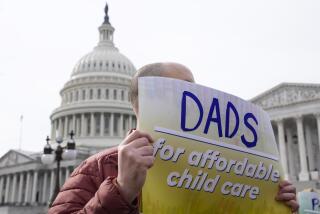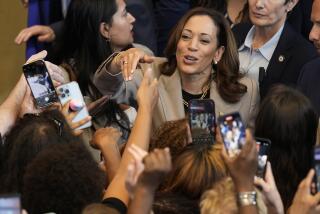White House Fighting a Quiet War on Poverty : Policy: The Administration boosts programs that aid poor. Critics say new Democrats are hiding old agenda.
- Share via
WASHINGTON — With none of the fanfare afforded health care reform or the North American Free Trade Agreement, the Clinton Administration has been moving quietly but quickly to put in place many pieces of a new federal anti-poverty effort.
The Administration has expanded or is pushing to beef up a select group of existing benefits, such as the earned income tax credit, food stamps, Head Start and federal assistance to schools to help poor children.
Some of the initiatives clearly are focused on relieving poverty--programs aimed at decreasing homelessness and stimulating business in depressed communities, for example. Other new programs, including national service, are couched in rhetoric about helping a broad spectrum of the population but are targeted at low-income individuals and poor communities.
“The Clinton Administration has done more in the poverty area than they’ve talked about,” said Robert Greenstein, executive director of the Center on Budget and Policy Priorities. “There’s a concern that if you start talking about an anti-poverty agenda, the middle class starts to think they’re being ignored. People in the Administration are concerned not to create this impression.”
Some Administration officials, members of Congress and political analysts say the Administration’s “stealth” anti-poverty policy reflects a deliberate attempt to avoid the stigma attached to old-style, big-spending Democrats. Rep. Xavier Becerra (D-Los Angeles) said the strategy is a clever one.
“If he had talked about the school-to-work or national service initiatives in the rubric of a war on poverty, they probably would have been shot down,” he said.
Robert E. Rubin, assistant to the President for economic policy, disagrees. If the President and his top aides have not articulated the links between their domestic agenda and their campaign against poverty, he said, it is merely because they have been consumed with health care, NAFTA, economic policy and crime.
The President’s anti-poverty initiatives reflect the public’s priorities, so there is no political reason to hide them, he said.
“They equip the poor to be part of the constructive work force,” Rubin said. “That’s really part of the so-called new Democratic policy.”
Rather than increasing funding across the board for anti-poverty programs, the Administration has concentrated on those that have been the most politically popular because they encourage people to work (the earned income tax credit) or focus on poor children (nutrition programs and immunizations).
“It’s what we were elected to do,” Labor Secretary Robert B. Reich said. “The putting-people-first campaign was all about investing in the work force. There is a difference between this and the older Democratic philosophy of redistributing wealth from the rich to the poor. It’s about giving everyone in society the capacity to be a constructive member of society.”
Some critics say the Administration has not made a big deal about its anti-poverty measures because they are not innovative and are too superficial to have a measurable effect on the intractable problems facing blighted areas.
“It’s old Democratic stuff,” said Doug Besharov, an analyst at the American Enterprise Institute for Public Policy Research, a think tank usually reflecting moderate Republican views. “A President who wants to be a new Democrat doesn’t go advertising his old Democratic policies.”
Besharov and Robert Rector, a welfare specialist at the conservative Heritage Foundation think tank, say that while the Administration talks about how these economically tight times are forcing government to cut back, the reality is different.
“They are really going on two tracks--a public track, which is focused on (putting people to) work, and a private track of throwing money on every welfare program we’ve ever had,” Rector said.
“Empowerment zones” and “enterprise communities,” 104 urban and rural areas that will get special federal aid to spark economic development, are examples of old ideas that the Administration is trotting out even though they are proven failures, Besharov and Rector say.
Administration officials say such statements reveal ignorance of the strategy behind their new projects. They express confidence that their programs, some of which have already been approved by Congress, will take root in communities.
The initiatives appear aimed at making a big splash with relatively little federal money, many of them by requiring state and local governments or the private sector to kick in funds.
The officials stress that solutions must come from the communities, not from Washington, and that the federal government should provide guidance and coordination, not directives.
For instance, the officials said:
* The school-to-work program, which has been passed by the House, would give money to school systems to develop on-the-job apprenticeships that would train non-college-bound young people for well-paying jobs.
* Empowerment zones and enterprise communities, enacted in August, will push local and state governments to work with private industry to come up with detailed plans to invigorate businesses in poor communities and put local people to work.
* The District of Columbia homeless initiative, which Congress has funded, will concentrate $20 million on a new strategy to prevent homelessness and help people get transitional and then permanent jobs and homes. The model developed in the District will then be replicated in other cities with large levels of homelessness.
* The national service program, signed into law in September, will put 20,000 young people to work in distressed areas, with a large percentage of them working in their own communities. The Administration hopes they will spark a renewed sense of civic responsibility among the people they are serving.
“You put those pieces together and you have a very comprehensive agenda for dealing with distressed communities,” said Andrew Cuomo, an assistant secretary of Housing and Urban Development. “It’s exactly the opposite of what they normally accuse politicians of: all talk and no action. This is all action and no talk.”
The Administration believes that many of the programs that will help the poor are the same programs that middle-class Americans need too. In this category are Clinton’s proposed health care reform and the enacted changes in the direct student-loan program, which will allow borrowers to pay back their education loans at a rate determined by their income.
But the President and his aides rarely articulate how these initiatives help the poor.
“It’s a smart approach,” said Rep. Craig Washington (D-Tex.), a member of the Congressional Black Caucus. “The people who have the least clout and the least influence . . . are poor people. If you stuck something out there like a sore thumb, it would never get passed. It’s more important to do something to help the poor than to beat your horn about it.”
Sen. Nancy Landon Kassebaum (R-Kan.), who supported the national service initiative, said she perceived it as a middle-class program until a few months after it was passed. Only when she reviewed the legislation did she see that it was heavily tilted toward poor communities and low-income participants.
“I hadn’t really thought about it in that light,” Kassebaum said.
Kassebaum and Becerra both said it is not clear if Clinton’s tactics will continue to work as the Administration tries to push through Congress its revamped version of a multibillion-dollar federal education program for economically distressed children in elementary and secondary schools.
The money now goes to almost every school district across the country, and the Administration wants to concentrate it in schools with the highest percentage of poor children. Cutting so many communities out of a federal aid program is bound to be controversial.
“I’d like the President to give an anti-poverty agenda more attention,” Becerra said. “But politically, can he realistically do it? I don’t think so.”
The lack of an articulated anti-poverty policy does not indicate a lack of high-level attention to the issue, Administration officials insist.
Robert Nash, undersecretary of agriculture for rural development, pointed out that the legislation authorizing the empowerment zones and enterprise communities also set up a Community Enterprise Board, whose chairman is Vice President Al Gore and whose members include most of the Cabinet.
“It’s not a piecemeal approach,” Nash said. “The Cabinet is coordinated on this board, which will provide grants and loans to communities when they decide what they want to do.”
State and local governments and the private sector will have to participate in planning and financing the projects brought before the board.
“Money will never flow from the federal government the way it used to,” Nash said. “We have to be more creative.”
More to Read
Get the L.A. Times Politics newsletter
Deeply reported insights into legislation, politics and policy from Sacramento, Washington and beyond. In your inbox three times per week.
You may occasionally receive promotional content from the Los Angeles Times.










